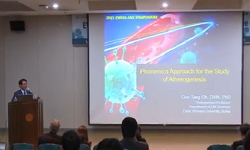Drought and salinity are the major environmental constrains in global agricultural production. Plant breeding for the drought and salt tolerance needs a proper assessment procedure to overcome stress constrain. Fundamental understanding on the physiol...
http://chineseinput.net/에서 pinyin(병음)방식으로 중국어를 변환할 수 있습니다.
변환된 중국어를 복사하여 사용하시면 됩니다.
- 中文 을 입력하시려면 zhongwen을 입력하시고 space를누르시면됩니다.
- 北京 을 입력하시려면 beijing을 입력하시고 space를 누르시면 됩니다.


Phenotyping of Plants for Drought and Salt Tolerance Using Infra-Red Thermography = Phenotyping of Plants for Drought and Salt Tolerance Using Infra-Red Thermography
한글로보기https://www.riss.kr/link?id=A101720906
-
저자
( Taek Ryoun Kwon ) ; ( Kyung Hwan Kim ) ; ( Hae Jin Yoon ) ; ( Seung Kon Lee ) ; ( Beom Ki Kim ) ; ( Zamin Shaheed Siddiqui ) (University of Karachi)

- 발행기관
- 학술지명
- 권호사항
-
발행연도
2015
-
작성언어
-
- 주제어
-
KDC
500
-
등재정보
KCI등재,SCOPUS
-
자료형태
학술저널
-
수록면
299-307(9쪽)
- DOI식별코드
- 제공처
-
0
상세조회 -
0
다운로드
부가정보
다국어 초록 (Multilingual Abstract)
Drought and salinity are the major environmental constrains in global agricultural production. Plant breeding for the drought and salt tolerance needs a proper assessment procedure to overcome stress constrain. Fundamental understanding on the physiological nature of the plant tolerance provides valuable information for the genetically modified crop`s development. Drought or salt stress induces several common physiological responses in plants such as water relation and photosynthetic capacitiy. It is because both stresses lead cellular dehydration in the plants, particularly, during the early phase of stress imposition. Drought and salinity decrease CO2 availability for photosynthesis via stomatal limitation as well as elevate leaf temperature due to partially closed stomata. In this scenario, stomatal regulation and plant water status are important aspects in abiotic stress environment. These physiological responses have a function to stabilize the temperature inside plant/leaf. Therefore phenotyping through an infra-red thermography (heat sensitive sensor), could be a useful tool in the selection of a tolerant genotypes. Infra-red thermography is a part of the electromagnetic spectrum which emits a certain amount of radiation as a function of their temperatures. In general, the plants which have less water, would have higher temperature and display more infra-red radiations. In abiotic stresses such as drought and salinity, plant water status is affected and varied from the sensitive to tolerant level. Infra-red images of plants are often linked with some of the physiological attributes to the tolerance. This review covers the limits, advantages, linkages, comparison and other prospectives of using thermal imagaes in modern phenotyping techniques.
동일학술지(권/호) 다른 논문
-
Targeted Genome Editing for Crop Improvement
- 한국육종학회
- ( Hyeran Kim )
- 2015
- KCI등재,SCOPUS
-
High-Throughput Phenotyping Platforms for Transgenic Plants in the Research and Product Development
- 한국육종학회
- ( Dong Yul Sung )
- 2015
- KCI등재,SCOPUS
-
Molecular Markers for Selecting Diverse Disease Resistances in Tomato Breeding Programs
- 한국육종학회
- ( Je Min Lee )
- 2015
- KCI등재,SCOPUS
-
Current Status of Knowledge and Research Perspectives in Korean Pear Genomics
- 한국육종학회
- ( Youngjae Oh )
- 2015
- KCI등재,SCOPUS




 ScienceON
ScienceON KISS
KISS



